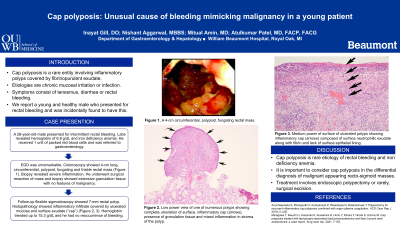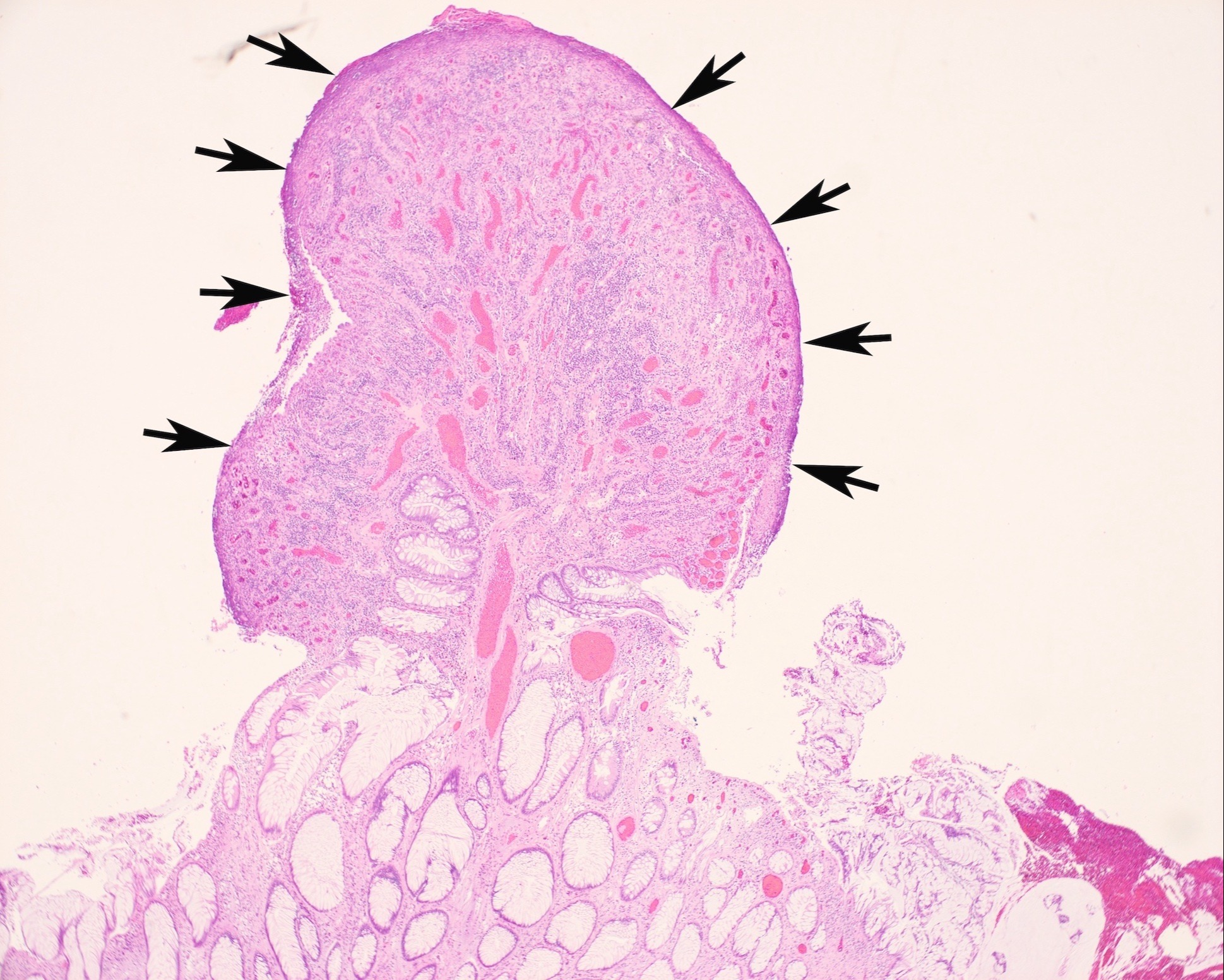Back


Poster Session D - Tuesday Morning
Category: GI Bleeding
D0326 - Unusual Cause of Bleeding Mimicking Malignancy in a Young Patient
Tuesday, October 25, 2022
10:00 AM – 12:00 PM ET
Location: Crown Ballroom

Has Audio

Inayat Gill, DO
William Beaumont Hospital
Royal Oak, MI
Presenting Author(s)
Inayat Gill, DO1, Nishant Aggarwal, MBBS2, Mitual Amin, MD1, Atulkumar Patel, MD, FACG1
1William Beaumont Hospital, Royal Oak, MI; 2Beaumont Health, Royal Oak, MI
Introduction: Cap polyposis, also referred to as inflammatory granulation tissue, is a very rare entity involving multiple inflammatory polyps commonly found in the sigmoid colon and rectum. It is often diagnosed incidentally when investigating other causes of iron deficiency anemia such as malignancy. We report a previously healthy and young athletic male who was discovered to have this.
Case Description/Methods: A 28-year-old athletic male with no medical history presented for intermittent rectal bleeding ongoing for a few years. He was evaluated for fatigue during a marathon run and was found to have hemoglobin of 6.8 g/dL (normal: 13.5-17g/dL) and iron deficiency anemia. He received 1 unit of packed red blood cells and was referred for a gastroenterology evaluation. The esophagogastroduodenoscopy was normal, however the colonoscopy identified a villous, fungating, infiltrative, polypoid and ulcerated 4-cm rectal mass starting at the anal verge which was identified as the source of the bleeding. Biopsy was consistent with inflammatory granulation tissue with mixed acute and chronic inflammation and there was no evidence of malignancy. He was referred to colorectal surgery for removal of mass due to continued bleeding, which he underwent 2 weeks later. His postoperative course was complicated by suture line bleeding requiring 2 packed red blood cells. 1 month post resection, his hemoglobin trended up to 15.3 with no reoccurrence of bleeding. The pathology showed no features of chronic infections or lymphoma. He remains healthy to this date.
Discussion: Cap polyposis is a rare etiology of rectal bleeding which sometimes presents as a worrisome rectal mass concerning for malignancy. Etiologies are suspected to be chronic mucosal irritation and infection. Symptoms may consist of tenesmus, diarrhea or rectal bleeding. It is a non-neoplastic and benign condition diagnosed via endoscopy and treatment involves polypectomy if feasible, or as in this case surgical removal. It is important to consider cap polyposis in the differential diagnosis of malignant appearing recto-sigmoid masses. It is not related to adenomatous polyps or inflammatory bowel disease.

Disclosures:
Inayat Gill, DO1, Nishant Aggarwal, MBBS2, Mitual Amin, MD1, Atulkumar Patel, MD, FACG1. D0326 - Unusual Cause of Bleeding Mimicking Malignancy in a Young Patient, ACG 2022 Annual Scientific Meeting Abstracts. Charlotte, NC: American College of Gastroenterology.
1William Beaumont Hospital, Royal Oak, MI; 2Beaumont Health, Royal Oak, MI
Introduction: Cap polyposis, also referred to as inflammatory granulation tissue, is a very rare entity involving multiple inflammatory polyps commonly found in the sigmoid colon and rectum. It is often diagnosed incidentally when investigating other causes of iron deficiency anemia such as malignancy. We report a previously healthy and young athletic male who was discovered to have this.
Case Description/Methods: A 28-year-old athletic male with no medical history presented for intermittent rectal bleeding ongoing for a few years. He was evaluated for fatigue during a marathon run and was found to have hemoglobin of 6.8 g/dL (normal: 13.5-17g/dL) and iron deficiency anemia. He received 1 unit of packed red blood cells and was referred for a gastroenterology evaluation. The esophagogastroduodenoscopy was normal, however the colonoscopy identified a villous, fungating, infiltrative, polypoid and ulcerated 4-cm rectal mass starting at the anal verge which was identified as the source of the bleeding. Biopsy was consistent with inflammatory granulation tissue with mixed acute and chronic inflammation and there was no evidence of malignancy. He was referred to colorectal surgery for removal of mass due to continued bleeding, which he underwent 2 weeks later. His postoperative course was complicated by suture line bleeding requiring 2 packed red blood cells. 1 month post resection, his hemoglobin trended up to 15.3 with no reoccurrence of bleeding. The pathology showed no features of chronic infections or lymphoma. He remains healthy to this date.
Discussion: Cap polyposis is a rare etiology of rectal bleeding which sometimes presents as a worrisome rectal mass concerning for malignancy. Etiologies are suspected to be chronic mucosal irritation and infection. Symptoms may consist of tenesmus, diarrhea or rectal bleeding. It is a non-neoplastic and benign condition diagnosed via endoscopy and treatment involves polypectomy if feasible, or as in this case surgical removal. It is important to consider cap polyposis in the differential diagnosis of malignant appearing recto-sigmoid masses. It is not related to adenomatous polyps or inflammatory bowel disease.

Figure: Low power view of one of the numerous polyps showing complete ulceration of the surface, inflammatory cap (arrows), presence of granulation tissue and mixed inflammation in the stroma of the polyp. The normal colonic mucosa can be appreciated at the bottom of the image.
Disclosures:
Inayat Gill indicated no relevant financial relationships.
Nishant Aggarwal indicated no relevant financial relationships.
Mitual Amin indicated no relevant financial relationships.
Atulkumar Patel indicated no relevant financial relationships.
Inayat Gill, DO1, Nishant Aggarwal, MBBS2, Mitual Amin, MD1, Atulkumar Patel, MD, FACG1. D0326 - Unusual Cause of Bleeding Mimicking Malignancy in a Young Patient, ACG 2022 Annual Scientific Meeting Abstracts. Charlotte, NC: American College of Gastroenterology.
